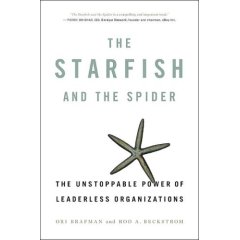Rod Beckstrom has founded, grown and successfully exited several businesses. But he is a curious sort of a guy…he wanted to know about the unstoppable power of leaderless organisations. So together with Ori Brafman, he set about researching those organisations that are so very successful but they have seemingly no leader. I got to meet him at the EO event in Tokyo.
He cited many interesting examples during his presentation on the power of organisations without known leaders. Alcoholics Anonymous an organisation with how many members? It is not clearly documented. More’s the point is that it operates without leadership. All you need is a few people who have a shared set of beliefs, are committed to an outcome and then they get together and make a difference. Rod notes that Alchiada operates in a similar way. That is why the Americans are having so much trouble tracking them down.
The most vivid example was how the Spanish conquered South America. With only 500 men the Spaniards took on the Aztec population of fifteen million, and within two years they had defeated them. The conquistadors found the king and the king’s family, they killed them all. And because the Aztec society depended on the head for the direction it quickly crumbled. The Spaniards did this throughout the whole of South America, and in just one century every civilisation had concurred. He uses the analogy that if you take the head of a spider it cannot survive.
However, this differed when the Spaniards came to America. Unlike the social structures of the Mayan’s and Aztec’s the American Indians whilst they had villages, became nomadic. The conquistadors could not find the leader. They thought it was Geronimo, 25% of military resources went into trying to track this person down. Even when he has killed the civilisation did not falter. This was a starfish type of structure, you could break off a group and it would then regenerate by itself, it does not require a head to survive.
The examples were vivid, but also the possibilities that were created were enormous. Rod posed the idea of peace on the planet, not based on a ‘war on terrorism’ but pods of people simply standing committed to a purpose.
I saw real parallels for organisational structures, I was working at Apple when Steve Jobs did not work there. When Steve returned what a vastly different organisation it became. This is a spider type organisation. But then consider Limewire this is a completely Starfish organisation. You literally cannot find it. Because it resides not even on servers but on people’s local hard drives.
Consider the history of music. Before recordings the only way you could hear an artist was in person, then there were many recording studios that ‘owned the music’, this was consolidated into only a few. They ‘owned’ the world’s music. But then Napster started. The big recording studios think they won the legal battle because they got a payment settlement. But something changed forever. Music was no longer owned by a few. Napster had servers where music is downloaded from. It was an organisation that could be sued. It had a leader and infrastructure. But the community now knows a new world of music so the likes of Limewire emerged. There is no servers or infrastructure to speak of. It is a community of people sharing the songs on their individual hard drives. There is no one to sue. This is a starfish, there is no leader. Starfish are hard to destroy.
As I look at my own expansion plans there was so much that I gleaned on evolving an organisation based on starfish rather than being a spider. More information about the book click on the image below.
Now Rod is a very interesting entrepreneur and there is much more to learn from him.





Angela Sands says
Hello Naomi!
Let me first say how inspired I have been by following the evolution of your own company over the years. Having read your book and identified with some of the difficult trials and tribulations that happen to all of us (!) it really has encouraged me to keep looking outside the square, alternative ways of viewing the issue, so thank you. There’s even been times I’ve said to myself, ‘I wonder what Naomi would have done?’
When I came across your write up regarding this book (by the way I have ordered it
from the States but won’t be here for 4-6 weeks), I am keen to understand the key fundamentals in the concept. You have mentioned in the media I read that you would be exploring ways to incorporate into your own environment and I was challenged to look at my own model also.
I looked at your examples used of companies which have applied this principle but would like to ask you what the key fundamentals were of the philosophy that you took away with you from your meeting OS / the book? Obviously I will be reading the book myself but I would be interested in your ‘take’ on the information in a little more depth.
If you can, I’d really appreciate it! Kind regards and thank you in advance …